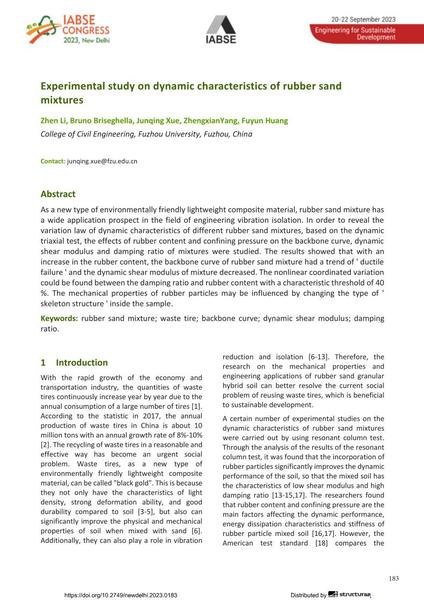Experimental study on dynamic characteristics of rubber sand mixtures

|
|
|||||||||||
Bibliografische Angaben
| Autor(en): |
Zhen Li
(College of Civil Engineering, Fuzhou University, Fuzhou, China)
Bruno Briseghella (College of Civil Engineering, Fuzhou University, Fuzhou, China) Junqing Xue (College of Civil Engineering, Fuzhou University, Fuzhou, China) Zhengxian Yang (College of Civil Engineering, Fuzhou University, Fuzhou, China) Fuyun Huang (College of Civil Engineering, Fuzhou University, Fuzhou, China) |
||||
|---|---|---|---|---|---|
| Medium: | Tagungsbeitrag | ||||
| Sprache(n): | Englisch | ||||
| Tagung: | IABSE Congress: Engineering for Sustainable Development, New Delhi, India, 20-22 September 2023 | ||||
| Veröffentlicht in: | IABSE Congress New Delhi 2023 | ||||
|
|||||
| Seite(n): | 183-190 | ||||
| Anzahl der Seiten (im PDF): | 8 | ||||
| DOI: | 10.2749/newdelhi.2023.0183 | ||||
| Abstrakt: |
As a new type of environmentally friendly lightweight composite material, rubber sand mixture has a wide application prospect in the field of engineering vibration isolation. In order to reveal the variation law of dynamic characteristics of different rubber sand mixtures, based on the dynamic triaxial test, the effects of rubber content and confining pressure on the backbone curve, dynamic shear modulus and damping ratio of mixtures were studied. The results showed that with an increase in the rubber content, the backbone curve of rubber sand mixture had a trend of ' ductile failure ' and the dynamic shear modulus of mixture decreased. The nonlinear coordinated variation could be found between the damping ratio and rubber content with a characteristic threshold of 40 %. The mechanical properties of rubber particles may be influenced by changing the type of ' skeleton structure ' inside the sample. |
||||
